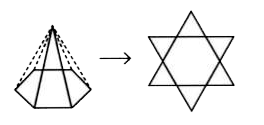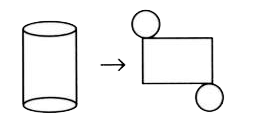Which of the following options represents the incorrect match of the given 3-D figures and their nets?




The correct Answer is:C
To solve the question of identifying the incorrect match of given 3-D figures and their nets, we can follow these steps:
Step 1: Understand the Concept of Nets
A net is a two-dimensional figure that can be folded to form a three-dimensional shape. Each face of the 3D figure corresponds to a part of the net.
Hint: Remember that a net includes all the faces of the 3D figure laid out flat.
Step 2: Analyze Each Option
We need to evaluate each option to see if the net correctly represents the corresponding 3D figure.
Hint: Look for the number of faces in the 3D figure and compare it with the net.
Step 3: Check the First Option
- The first figure is a pyramid. When opened, it should show a base and triangular faces.
- Count the faces: 1 base + 4 triangular faces = 5 faces.
- The net shows 5 parts, which matches.
Hint: Ensure that all faces are represented in the net.
Step 4: Check the Second Option
- The second figure is a cylinder. The net should consist of a rectangle (the curved surface) and two circles (the top and bottom).
- Count the parts: 1 rectangle + 2 circles = 3 parts.
- The net shows 3 parts, which matches.
Hint: Each part of the net should correspond to a face of the 3D figure.
Step 5: Check the Third Option
- The third figure is a cuboid. A cuboid has 6 faces (2 rectangles for the top and bottom, and 4 rectangles for the sides).
- Count the parts in the net: If there are only 5 parts shown, one face is missing.
Hint: A cuboid must have 6 faces in its net.
Step 6: Check the Fourth Option
- The fourth figure is a cone. The net should consist of a circle (the base) and a triangle (the lateral surface).
- Count the parts: 1 circle + 1 triangle = 2 parts.
- The net shows 2 parts, which matches.
Hint: Ensure that the net includes all necessary components for the 3D shape.
Conclusion
After analyzing all options, we find that the third option is incorrect because the net of the cuboid is missing one face.
Final Answer: The incorrect match is the third option.
A net is a two-dimensional figure that can be folded to form a three-dimensional shape. Each face of the 3D figure corresponds to a part of the net.
We need to evaluate each option to see if the net correctly represents the corresponding 3D figure.
- The first figure is a pyramid. When opened, it should show a base and triangular faces.
- Count the faces: 1 base + 4 triangular faces = 5 faces.
- The net shows 5 parts, which matches.
- The second figure is a cylinder. The net should consist of a rectangle (the curved surface) and two circles (the top and bottom).
- Count the parts: 1 rectangle + 2 circles = 3 parts.
- The net shows 3 parts, which matches.
- The third figure is a cuboid. A cuboid has 6 faces (2 rectangles for the top and bottom, and 4 rectangles for the sides).
- Count the parts in the net: If there are only 5 parts shown, one face is missing.
- The fourth figure is a cone. The net should consist of a circle (the base) and a triangle (the lateral surface).
- Count the parts: 1 circle + 1 triangle = 2 parts.
- The net shows 2 parts, which matches.
After analyzing all options, we find that the third option is incorrect because the net of the cuboid is missing one face.
Topper's Solved these Questions
- IMO QUESTION PAPER 2020-21 SET ABOOK - SCIENCE OLYMPIAD FOUNDATION CHAPTER - IMO QUESTION PAPER 2020-21 SET AEXERCISE - EVERYDAY MATHEMATICS
10 Videos
- IMO QUESTION PAPER 2019-20 SET BBOOK - SCIENCE OLYMPIAD FOUNDATION CHAPTER - IMO QUESTION PAPER 2019-20 SET BEXERCISE - Achievers section
5 Videos
- SAMPLE PAPER 4 (CLASS VII)BOOK - SCIENCE OLYMPIAD FOUNDATION CHAPTER - SAMPLE PAPER 4 (CLASS VII)EXERCISE - Section A- Mathematics
10 Videos
Similar Questions
Knowledge Check
Which of the following option is incorrect
AIst ionisation potential : Na<Mg<Si<PBElectron affinity : N<C<O<F<ClCHydrated radius : Ba2+(aq)<Sr2+(aq)<Mg2+(aq)DPolarity order : N−H<Sb−H<As−H<P−HWhich of the following option is incorrect
AIst ionisation potential : Na<Mg<Si<PBElectron affinity : N<C<O<F<ClCHydrated radius : Ba2+(aq)<Sr2+(aq)<Mg2+(aq)DPolarity order : N−H<Sb−H<As−H<P−HWhich of the following option is incorrect
AIst ionisation potential : Na<Mg<Si<PBElectron affinity : N<C<O<F<ClCHydrated radius : Ba2+(aq)<Sr2+(aq)<Mg2+(aq)DPolarity order : N−H<Sb−H<As−H<P−H

